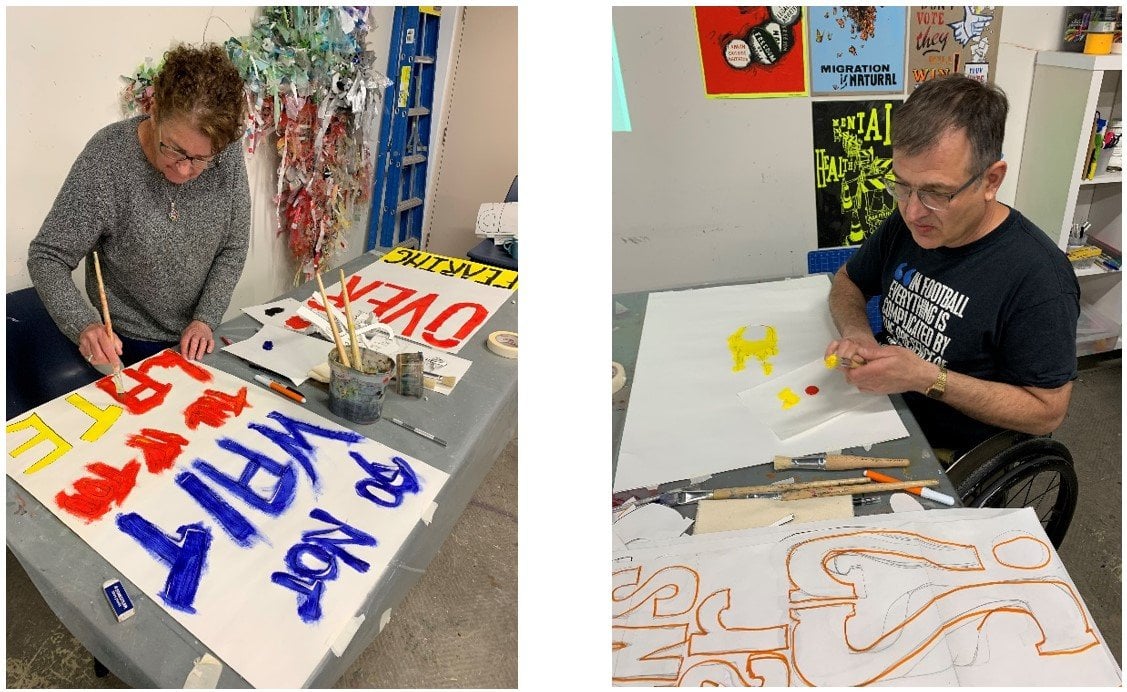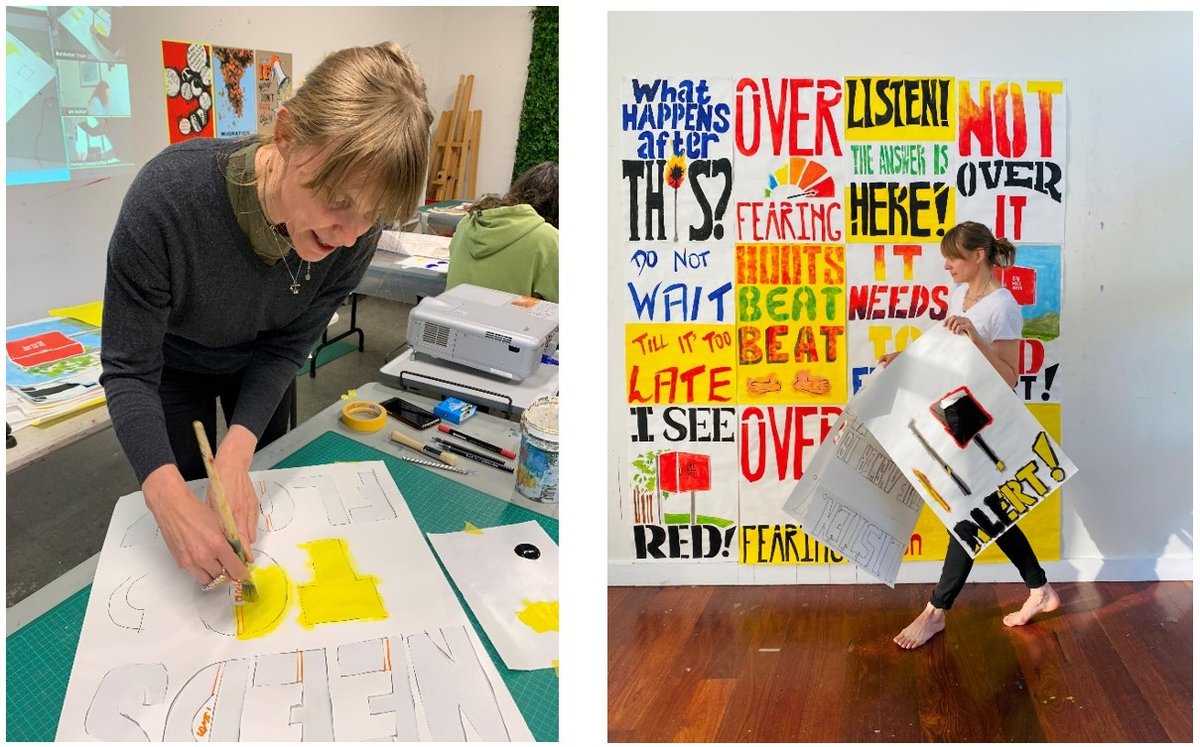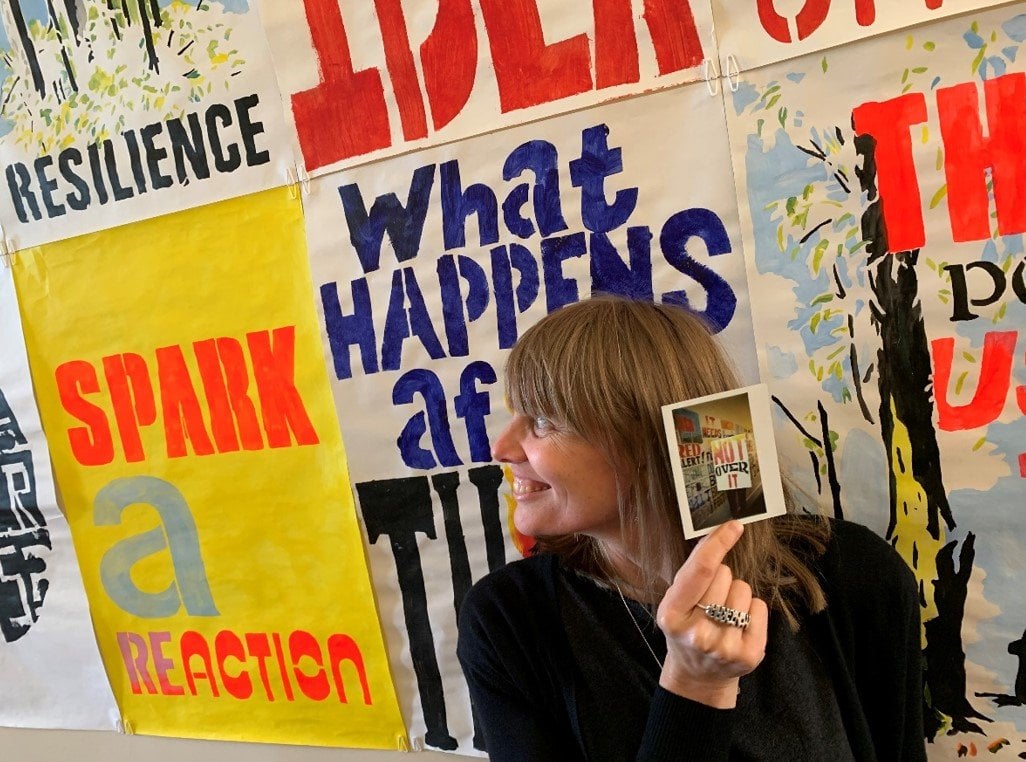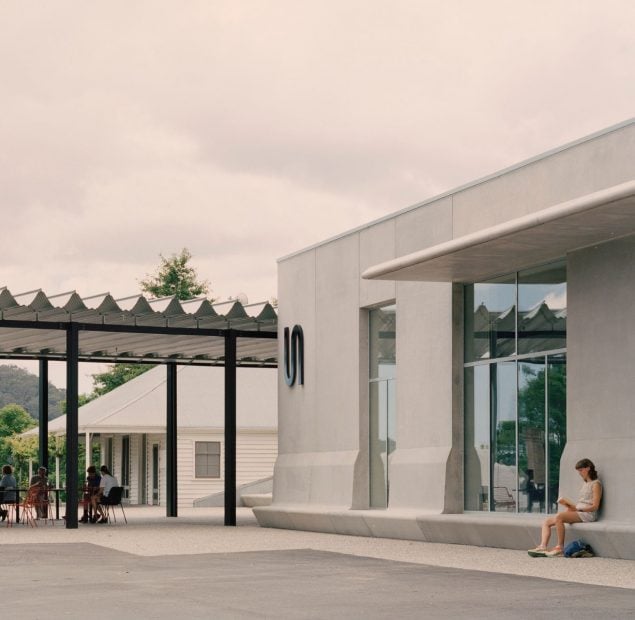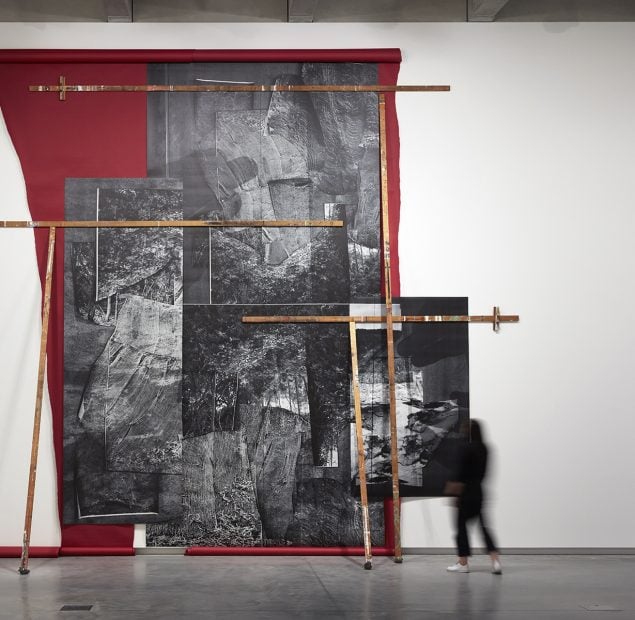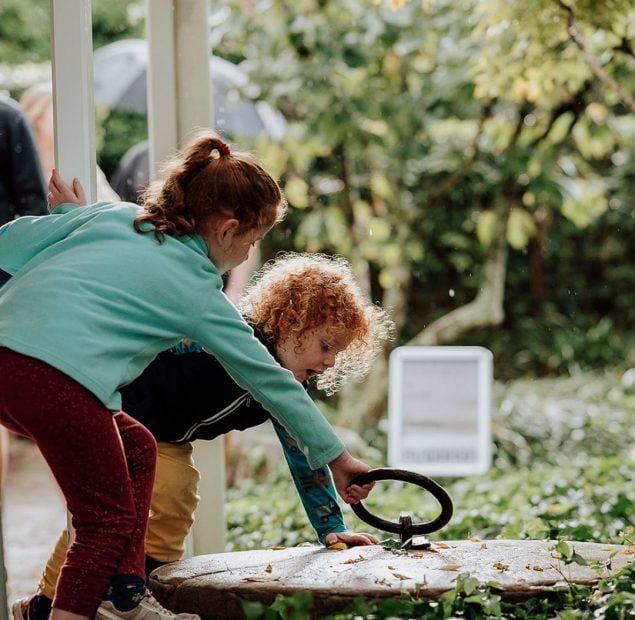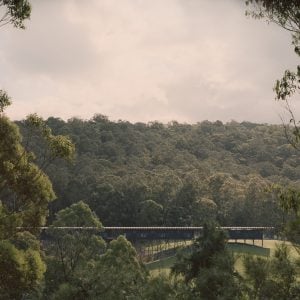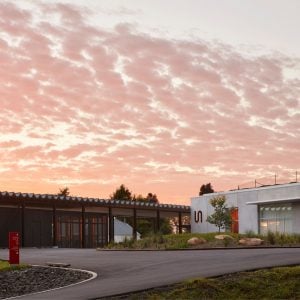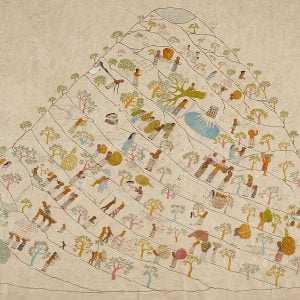Sophie O’Brien, Head of Curatorial and Learning at Bundanon recently sat down with artist and poster maker Wendy Murray to chat about the importance of poster making, voicing opinions and wanting to change the world.
Sophie O’Brien: You recently facilitated three poster making workshops for Bundanon with our Shoalhaven community focusing on the theme of fire, how did you find these workshops?
Wendy Murray: They were fantastic! Before I came down to Bundanon and were planning, I resisted doing research on the impact of the fire on this community. I had heard a bit, through the staff here, other artists and acquaintances and obviously through the media. At the time, I was in Los Angeles and it was on the local news because they face similar issues over there. But what I really wanted from the workshops was to listen and hear the community. So, I came with no preconceived idea of how we were going to go or how people would respond to the fires.
SO: And it’s still really recent.
WM: The landscape is still raw from it, it’s still really present. It was really interesting talking to folks about it. What I found most interesting, with all three workshops, was the positivity – there wasn’t anger there, there was a lot of positivity. One of the young artists said to me “You know it’s so great that we all band together as a community after a disaster, why don’t we band together as a community before?”. There were some really interesting things that came out of it and some fabulous posters.
SO: When someone goes through a crisis, they often change their life because they have been pulled out of their normal circumstance. So much of your work is a response to change or the desire for change, do you think that it’s often crisis that creates change?
WM: I think my work responds to the environment I am in directly. I’m a conduit for what’s around me, I’m very sensitive, I feel conflict. You could put me anywhere and I would probably feel a change required somewhere, somehow. It’s overwhelming coming into community right now. A poster one of the workshop artists made read “I have no idea” and I really get that sense of being quite overwhelmed. I’ve got 25 sheets here of ideas from the community for the direction these posters could go in, it’s so broad. “Can’t give enough love” was another idea for a poster… a lot of the issues addressed in the workshops are pertinent. I could take these posters to Los Angeles with me and I could put them on the street, and everyone would relate to them.
SO: People actually have a huge amount to say about their feelings, but also thoughts on politics. If you look at the work of artist Gillian Wearing, people are a wealth of material and often the only thing missing is the handwritten sign.
WM: Yeah, and the confidence. The confidence in your community to voice your opinion. I think the way communities are structured, the social structures, are quite prohibitive. For example, if you are a young person or if you are at a disadvantage for whatever reason, you might not feel it’s your place – but if we all voiced our opinions then there might not be any big conflict. Issues could be resolved along the way; change would happen gradually throughout the community if we talked about these things on a regular basis. There would probably be less inclination for it to all blow up. For it to be all or nothing.
SO: You have a wonderful ability to hold space, to allow participants to voice these opinions, to bring in any political view, feeling or statement. It’s all about expression. Is this built in or something you have had to develop?
WM: I think it comes from working with different communities and in different workshop environments. I am predominantly a screen printer and I have done a lot of that in community print studios working collaboratively with members of the community. I have been privileged to work with Self Help Graphics in east LA, for that community to invite me in and let me work with them, to be an outsider and be welcomed, is incredible. I learnt so much about how to treat people.
SO: There seems to be an energy for politics, for example, at Creative Time in New York, gender and race politics, that is different to Australia. A lot of the political art comes out of a social and political idea of how to approach participatory projects. Do you feel that there is an energy in LA that feeds what you do?
WM: It’s quite hard to put my finger on, but what is interesting about the US and what draws me to it are the contradictions. There is a racism, a sexism and a class division there and as a poster maker I feel like I have a golden ticket. Because poster makers, in my experience, welcome each other. It’s an open, caring community as we all have the same motivations: to make the world a better place. We are idealists. There’s a strong generational history there; there is the Centre for the Study of Political Graphics in Los Angeles. I often go there, to research and look at posters and that’s my jumping off point. So, when I step into that world, I’ve got a form of protection; a wayfinding system that allows me through the community easier than it would if I was outside of the screen-printing community. I don’t think that’s exactly the same [for other artforms].
SO: Do you think that that there is an immediacy to this “wanting to change the world”? The process seems very hands on – you make the posters, you put them up…
WM: You are on the front line. In the studio I’m working with other artists while I make my posters, alongside or collaborating. I print the poster, then I walk down street and put the poster on the pole. I’m interacting with community or law enforcement or institutions. Then that poster gets collected, so then I’m in institutions and then it’s in a different space. I can put that poster online and that introduces me to a broader audience. It’s mediated, it’s controlled by you, you take care of it. I manage that whole process, I’m privy to it, my hands are in every part of it.
SO: In terms of the posters coming out of the workshops – you must get a lot of different options, different people, viewpoints, skills etc. I imagine you gather a lot of material. What’s your process after that?
WM: Here I asked the participants if it was ok to use some of the brainstorming ideas that we came up with together, some of the poster ideas that they didn’t use, as a sort of springboard for my own work. I have this pile of 25-30 sheets of mind mapping word association, that I will go through and look at some keys things to respond to.
SO: These mind maps you did with the participants, is this the place you start in your own practice?
WM: I take the community through the same process I go through to make a poster, [looking at] something that has happened to me or a friend, in my environment, or community; something I want to respond to. I sit down, write some words and do some word association – puns, similes or metaphors – then build a bit of humour in there. Then I look at typographies, how do I describe these words, what order they go in, where the rhythm is, where the emphasise is and then consider if the text needs to be supported by an image.
Most of my posters are done in 3 or 4 hours, usually because they are so immediate. It’s about what’s happening now. I’ll make them that afternoon or the next morning and I’ll have them on the street, sometimes within a day. In the [Bundanon] workshops I took the artists through my process so they could experience it. I joked in the workshops that we had a protest at 3 o’clock, so at 2 o’clock I said “The cops are outside, we’ve got to get out there. ABC news is here, we’ve got to make our posters! Come on people, don’t wait!” to give a sense of urgency. We have done the hard work, the mind mapping, we’ve got the text and it’s really good and succinct. We have tested it on everyone in the room and they agree, so you’re onto a winner. Now just go and smash out the poster!
SO: You see that in protests where people have an awesome message and it’s quick, it’s on a piece of paper. There is speed and immediacy. People have used an A4 piece of paper and a texta, a poster made as they were leaving the house.
WM: Yes totally! We have to trust our intuition. It’s not often we get to just kick back and feel, just go for the ride and make it. How often do you get to do that in life, just trust your intuition and make something without questioning it?
SO: That phrase “yesterday’s news” that is associated with newsprint – do you ever feel that with your posters? You have an archive of amazing posters, is this something you have consciously created?
WM: It’s accidental. It’s because I would print a hundred posters. I’d put them on the street every Monday night in different suburbs. I might take 25 posters and go out for 3 hours and only get 18 posters up, so I would put the rest under my bed and forget about them. I’d move onto the next poster. That was yesterday’s news, it doesn’t have any relevance anymore or I’m sick of putting it up or I’ve got something else I want to say. So that archive just came out of accidentally having left over posters. For years I didn’t have a way to sell my posters, nor was I motivated to sell them, so I just put them in a box or the file draw.
SO: It’s so great to see the course of thinking and the course of making. The archive becomes a social document. WM: Yeah, it’s a social document of what was happening. There are things that happen in time, decisions we make – the outcomes are recorded in history but the feeling and the community’s feeling around that are often lost.
SO: Why do you want to share the skills of poster making? In terms of that immediacy, is that the thing you like to share, being able to express something, the quick turnaround – I think, I make, I put it up..?
WM: I did street art for years and there is a code in the street art graffiti world – your paste recipe is your secret right – and I got to a point, where I was doing a workshop with young women in Sydney and they asked me about my paste recipe and I thought, “I want you to go out there and put posters up, why would I hold it back? What if I died tomorrow and I hadn’t shared this amazing thing!” So, I said, have my recipe. The poster making is the same. If I can show you how to make posters and you can go home and show your family, they can show their friends, then I’m making the world a better place. That’s why I teach. I mean I love to do, I could make my posters all day but the main reason I teach is so that there is a legacy of poster making. It really isn’t a thing in Australia. In North America I could probably get a job designing posters for not-for-profits, whereas that job or market doesn’t tend to exist so much here in Australia, a lot of it is done in-house by graphic designers, not poster makers.
SO: When you are facilitating a workshop, are you learning from your participants as much as they are learning from you and what do you take away from that experience? How does this all fold into your ongoing process’?
WM: I think in the [recent] workshops I learnt to listen, working through and workshopping ideas. I learnt that all the people in the workshops want a positive change, collective prevention ideas: working with land, broad environmental ideas, comfort… It all folds in. Every experience I have I carry with me, and now and then it comes out. I might make a series of posters in response to this over the next few weeks, but it might not be until next summer in LA when they go through their wildfire season that something comes up. And where I can, I will always give people credit for that. Collaboration is an important part of my practice.

